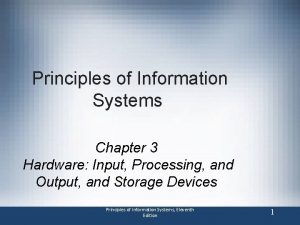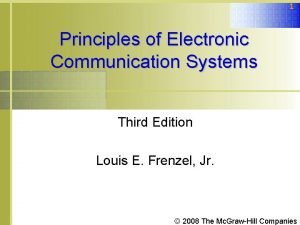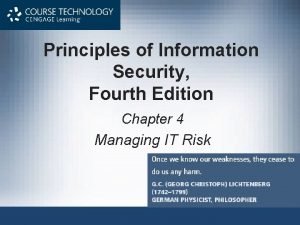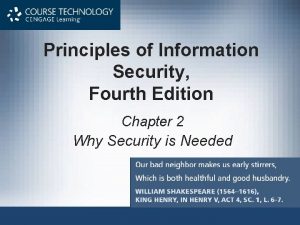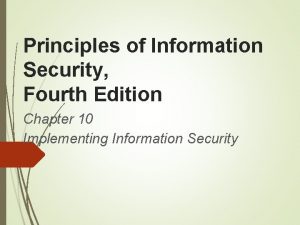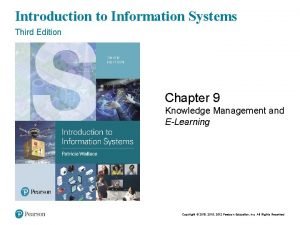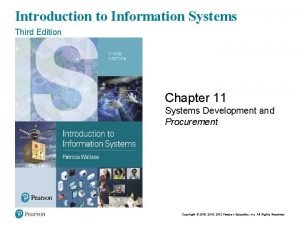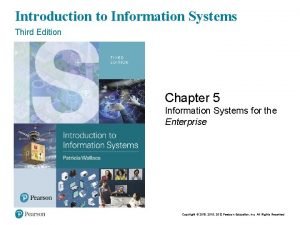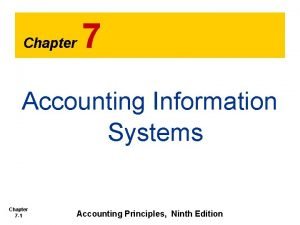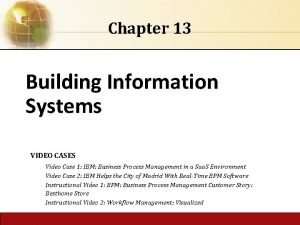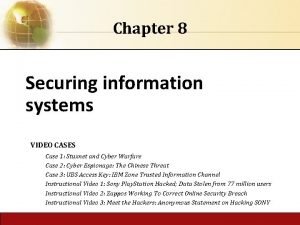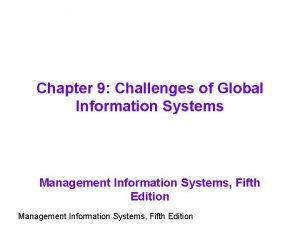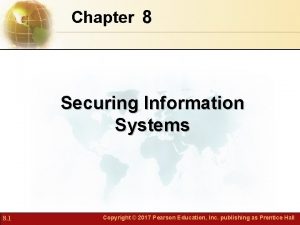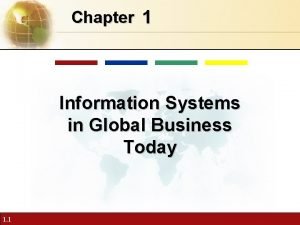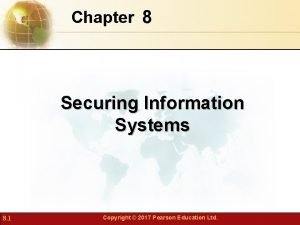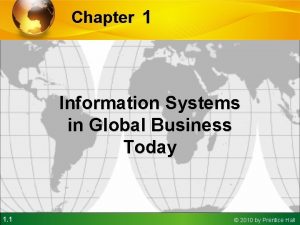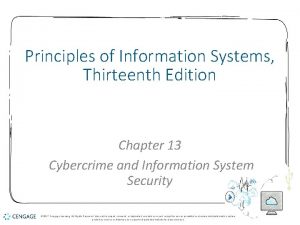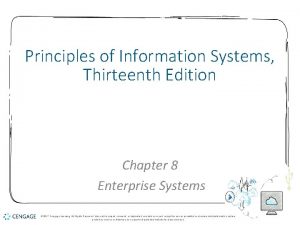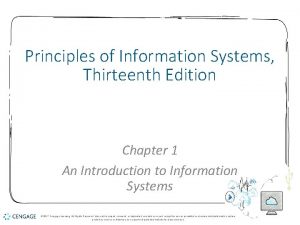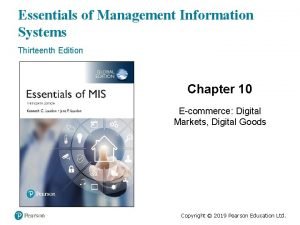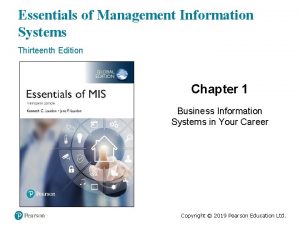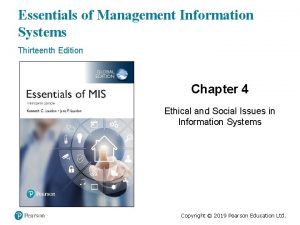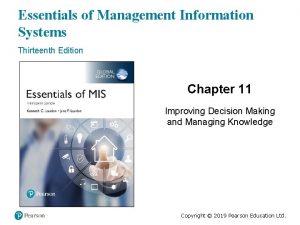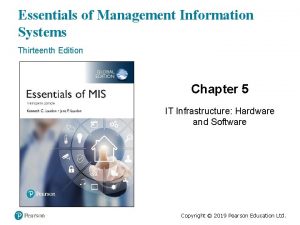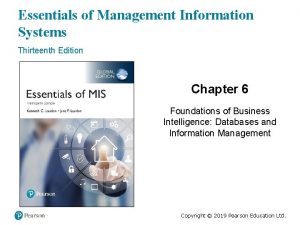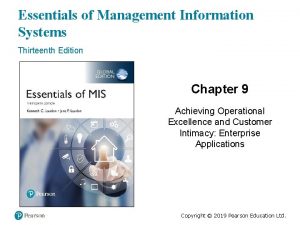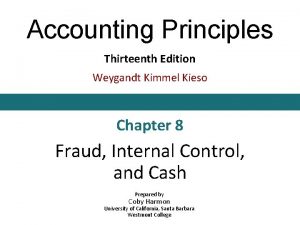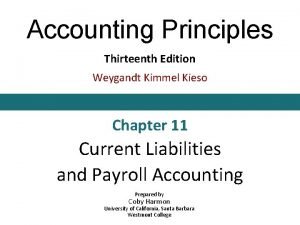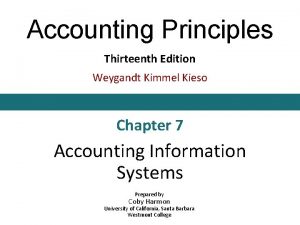Principles of Information Systems Thirteenth Edition Chapter 13





























































- Slides: 61

Principles of Information Systems, Thirteenth Edition Chapter 13 Cybercrime and Information System Security © 2017 Cengage Learning. All Rights Reserved. May not be copied, scanned, or duplicated, in whole or in part, except for use as permitted in a license distributed with a certain product or service or otherwise on a password-protected website for classroom use. 1

Objectives After completing this chapter, you will be able to: Explain why computer incidents are so prevalent Identify and briefly describe the types of computer exploits and their impact Describe the earmarks of a strong security program Identify specific measures used to prevent computer crime Outline actions that must be taken in the event of a successful security intrusion © 2017 Cengage Learning. All Rights Reserved. May not be copied, scanned, or duplicated, in whole or in part, except for use as permitted in a license distributed with a certain product or service or otherwise on a password-protected website for classroom use.

The Threat Landscape • Number of cybercrimes are increasing • Organizations are putting in place a range of countermeasures to combat cybercrime • Computer security incidents surged from 2014 to 2015 in the following industries: • • • Public sector organizations Entertainment, media, and communications Technology and telecommunications companies Pharmaceuticals and life sciences Power and utilities organizations © 2017 Cengage Learning. All Rights Reserved. May not be copied, scanned, or duplicated, in whole or in part, except for use as permitted in a license distributed with a certain product or service or otherwise on a password-protected website for classroom use. 3

Why Computer Incidents Are So Prevalent • Increasing Complexity Increases Vulnerability • Cloud computing, networks, computers, mobile devices, virtualization, OS applications, Web sites, switches, routers, and gateways are interconnected and driven by millions of lines of code • Higher Computer User Expectations • Computer help desks are under intense pressure to respond very quickly to users’ questions • Expanding and Changing Systems Introduce New Risks • It is difficult for IT organizations to keep up with the pace of technological change, successfully perform an ongoing assessment of new security risks, and implement approaches for dealing with them © 2017 Cengage Learning. All Rights Reserved. May not be copied, scanned, or duplicated, in whole or in part, except for use as permitted in a license distributed with a certain product or service or otherwise on a password-protected website for classroom use. 4

Why Computer Incidents Are So Prevalent • Increased Prevalence of Bring Your Own Device Policies • Bring your own device (BYOD): a business policy that permits (encourages) employees to use their own mobile devices to access company computing resources and applications • BYOD makes it difficult for IT organizations to adequately safeguard additional portable devices with various OSs and applications • Growing Reliance on Commercial Software with Known Vulnerabilities • An exploit is an attack on an information system that takes advantage of a particular system vulnerability - Often this attack is due to poor system design or implementation • Users should download and install patches for known fixes to software vulnerabilities - Any delay in doing so exposes the user to a potential security breach © 2017 Cengage Learning. All Rights Reserved. May not be copied, scanned, or duplicated, in whole or in part, except for use as permitted in a license distributed with a certain product or service or otherwise on a password-protected website for classroom use. 5

Why Computer Incidents Are So Prevalent © 2017 Cengage Learning. All Rights Reserved. May not be copied, scanned, or duplicated, in whole or in part, except for use as permitted in a license distributed with a certain product or service or otherwise on a password-protected website for classroom use. 6

Why Computer Incidents Are So Prevalent • Increasing Sophistication of Those Who Would Do Harm • Today’s computer menace is organized and may be part of an organized group that has an agenda and targets specific organizations and Web sites © 2017 Cengage Learning. All Rights Reserved. May not be copied, scanned, or duplicated, in whole or in part, except for use as permitted in a license distributed with a certain product or service or otherwise on a password-protected website for classroom use. 7

Key Information Security Terms Information Security refers to all of the processes and policies designed to protect an organization’s information and information systems from unauthorized access, use, disclosure, disruption, modification, or destruction. Threat any danger to which a system may be exposed. Exposure the harm, loss or damage that can result if a threat compromises that resource. Vulnerability the possibility that the system will suffer harm by a threat. 8

Five Factors Increasing the Vulnerability of Information Resources 1. Today’s interconnected, interdependent, wirelessly-networked business environment 2. Smaller, faster, cheaper computers and storage devices 3. Decreasing skills necessary to be a hacker 4. Organized crime taking over cybercrime 5. Lack of management support 9

Security Threats 10

Human Errors Carelessness with laptops and portable computing devices Opening questionable e-mails Careless Internet surfing Poor password selection and use And more (see table 4. 1) Most Dangerous Employees • HUMAN RESOURCE • MIS 11

Social Engineering Social engineering is an attack where the attacker uses social skills to trick a legitimate employee into providing confidential company information such as passwords. Two examples • Tailgating • Shoulder surfing © Purestock/Age Fotostock America, Inc 12

Deliberate Threats to Information Systems • Espionage or Trespass • Information extortion • Sabotage or vandalism • Theft of equipment or information (dumpster diving) • Identity theft • Compromises to intellectual property • Soft ware attacks • Alien soft ware • Supervisory control and data acquisition (SCADA) attacks • botnet and spam • distributed denial of service (DDOS) • advanced persistent threat • Cyberterrorism and cyberwarfare 13

Compromises to intellectual property • Intellectual property. Property created by individuals or corporations which is protected under trade secret, patent, and copyright laws. • Trade secret. Intellectual work, such as a business plan, that is a company secret and is not based on public information. • Patent. Document that grants the holder exclusive rights on an invention or process for 20 years. • Copyright. Statutory grant that provides creators of intellectual property with ownership of the property for life of the creator plus 70 years. 14

Software attacks • A virus is a segment of computer code that performs malicious actions by attaching to another computer program. • A worm is a segment of computer code that spreads by itself and performs malicious actions without requiring another computer program. • A Trojan horse is a software program that hides in other computer programs and reveal its designed behavior only when it is activated. • A logic bomb is a segment of computer code that is embedded within an organization’s existing computer programs and is designed to activate and perform a destructive action at a certain time and date. • Ransomware is Malware that stops you from using your computer or accessing your data until you meet certain demands such as paying a ransom or sending photos to the attacker • Distributed denial-of-service attacks the attacker first takes over many computers. These computers are called zombies or bots. Together, these bots form a botnet. - See botnet demonstration 15

Types of Exploits • Blended Threat • A sophisticated threat that combines the features of a virus, worm, Trojan horse, and other malicious code into a single payload • Might use server and Internet vulnerabilities to initiate and then transmit and spread an attack using EXE files, HTML files, and registry keys • Spam • The use of email systems to send unsolicited email to large numbers of people • Also an inexpensive method of marketing used by many legitimate organizations • Controlling the Assault of Non-Solicited Pornography and Marketing (CAN-SPAM) Act states that it is legal to spam, provided the messages meet a few basic requirements - Spammers cannot disguise their identity by using a false return address - The email must include a label specifying that it is an ad or a solicitation - The email must include a way for recipients to opt out of future mass mailings © 2017 Cengage Learning. All Rights Reserved. May not be copied, scanned, or duplicated, in whole or in part, except for use as permitted in a license distributed with a certain product or service or otherwise on a password-protected website for classroom use. 16

Types of Exploits • Spam (cont’d) • CAPTCHA (Completely Automated Public Turing Test to Tell Computers and Humans Apart) software generates and grades tests that humans can pass and all but the most sophisticated computer programs cannot © 2017 Cengage Learning. All Rights Reserved. May not be copied, scanned, or duplicated, in whole or in part, except for use as permitted in a license distributed with a certain product or service or otherwise on a password-protected website for classroom use. 17

Deliberate Threats (continued) Alien Software Spyware (see video) collects personal information about users without consent like keystroke loggers and screen scrapers. Spamware Cookies Supervisory control and data acquisition (SCADA) attacks Links the physical and electronic world • example power outages like one in 2003 © Manfred Grafweg/Age Fotostock America, Inc. 18

Types of Exploits • Distributed Denial-of-Service Attacks • An attack in which a malicious hacker takes over computers via the Internet and causes them to flood a target site with demands for data and other small tasks • Keeps target so busy responding to requests that legitimate users cannot get in • Botnet - A large group of computers, controlled from one or more remote locations by hackers, without the consent of their owners - Sometimes called zombies - Frequently used to distribute spam and malicious code © 2017 Cengage Learning. All Rights Reserved. May not be copied, scanned, or duplicated, in whole or in part, except for use as permitted in a license distributed with a certain product or service or otherwise on a password-protected website for classroom use. 19

Types of Exploits © 2017 Cengage Learning. All Rights Reserved. May not be copied, scanned, or duplicated, in whole or in part, except for use as permitted in a license distributed with a certain product or service or otherwise on a password-protected website for classroom use. 20

Types of Exploits • Rootkit • A set of programs that enables its user to gain administrator-level access to a computer without the end user’s consent or knowledge • Attackers can use the rootkit to execute files, access logs, monitor user activity, and change the computer’s configuration • Symptoms of rootkit infections: - Computer locks up or fails to respond to input from the keyboard - Screen saver changes without any action on the part of the user - Taskbar disappears - Network activities function extremely slow © 2017 Cengage Learning. All Rights Reserved. May not be copied, scanned, or duplicated, in whole or in part, except for use as permitted in a license distributed with a certain product or service or otherwise on a password-protected website for classroom use. 21

Types of Exploits • Advanced Persistent Threat • APT is a network attack in which an intruder gains access to a network and stays undetected with the intention of stealing data over a long period of time • An APT attack advances through the following five phases: - Reconnaissance - Incursion - Discovery - Capture - Export • Detecting anomalies in outbound data is the best way for administrators to discover that the network has been the target of an APT attack © 2017 Cengage Learning. All Rights Reserved. May not be copied, scanned, or duplicated, in whole or in part, except for use as permitted in a license distributed with a certain product or service or otherwise on a password-protected website for classroom use. 22

Types of Exploits • Phishing • The act of fraudulently using email to try to get the recipient to reveal personal data • Con artists send legitimate-looking emails urging recipients to take action to avoid a negative consequence or to receive a reward • Spear-phishing is a variation of phishing where fraudulent emails are sent to a certain organization’s employees - Much more precise and narrow - Designed to look like they came from high-level executives within organization © 2017 Cengage Learning. All Rights Reserved. May not be copied, scanned, or duplicated, in whole or in part, except for use as permitted in a license distributed with a certain product or service or otherwise on a password-protected website for classroom use. 23

Phishing attacks - Phishing slideshow - Phishing quiz - Phishing example 24

Types of Exploits © 2017 Cengage Learning. All Rights Reserved. May not be copied, scanned, or duplicated, in whole or in part, except for use as permitted in a license distributed with a certain product or service or otherwise on a password-protected website for classroom use. 25

Types of Exploits • Smishing and Vishing • Smishing is a variation of phishing that involves the use of texting • Vishing is similar to smishing except the victims receive a voice mail message telling them to call a phone number or access a Web site • Identity Theft • The theft of personal information and then used without their permission • Data breach is the unintended release of sensitive data or the access of sensitive data by unauthorized individuals - Often results in identity theft • Most e-commerce Web sites use some form of encryption technology to protect information as it comes from the consumer © 2017 Cengage Learning. All Rights Reserved. May not be copied, scanned, or duplicated, in whole or in part, except for use as permitted in a license distributed with a certain product or service or otherwise on a password-protected website for classroom use. 26

Types of Exploits • Cyberespionage • Involves the development of malware that secretly steals data in the computer systems of organizations, such as government agencies, military contractors, political organizations, and manufacturing firms • Mostly targeted toward high-value data such as the following: - Sales, marketing, and new product development plans, schedules, and budgets - Details about product designs and innovative processes - Employee personal information - Customer and client data - Sensitive information about partners and partner agreements © 2017 Cengage Learning. All Rights Reserved. May not be copied, scanned, or duplicated, in whole or in part, except for use as permitted in a license distributed with a certain product or service or otherwise on a password-protected website for classroom use. 27

Types of Exploits • Cyberterrorism • The intimidation of government of civilian population by using information technology to disable critical national infrastructure to achieve political, religious, or ideological goals • Department of Homeland Security (DHS) provides a link that enables users to report cyber incidents - Incident reports go to the U. S. Computer Emergency Readiness Team (US-CERT) • Cyberterrorists try daily to gain unauthorized access to a number of important and sensitive sites © 2017 Cengage Learning. All Rights Reserved. May not be copied, scanned, or duplicated, in whole or in part, except for use as permitted in a license distributed with a certain product or service or otherwise on a password-protected website for classroom use. 28

Federal Laws for Prosecuting Computer Attacks © 2017 Cengage Learning. All Rights Reserved. May not be copied, scanned, or duplicated, in whole or in part, except for use as permitted in a license distributed with a certain product or service or otherwise on a password-protected website for classroom use. 29

Implementing Secure, Private, Reliable Computing • A strong security program begins by • Assessing threats to the organization’s computers and network • Identifying actions that address the most serious vulnerabilities • Educating users about the risks involved and the actions they must take to prevent a security incident • If an intrusion occurs, there must be a clear reaction plan that addresses: • • • Notification Evidence protection Activity log maintenance Containment Eradication Recovery © 2017 Cengage Learning. All Rights Reserved. May not be copied, scanned, or duplicated, in whole or in part, except for use as permitted in a license distributed with a certain product or service or otherwise on a password-protected website for classroom use. 30

Risk Assessment • Risk assessment • The process of assessing security-related risks to an organization’s computer and networks form both internal and external threats • Steps in a general risk assessment process are: • • Identify the set of IS assets about which the organization is most concerned Identify the loss events or the risks or threats that could occur Assess the frequency of events or the likelihood of each potential threat Determine the impact of each threat occurring Determine how each threat can be mitigated so it is less likely to occur Assess the feasibility of implementing the mitigation options Perform a cost-benefit analysis to ensure that your efforts will be cost effective Make the decision on whether or not to implement a particular countermeasure © 2017 Cengage Learning. All Rights Reserved. May not be copied, scanned, or duplicated, in whole or in part, except for use as permitted in a license distributed with a certain product or service or otherwise on a password-protected website for classroom use. 31

Risk Assessment © 2017 Cengage Learning. All Rights Reserved. May not be copied, scanned, or duplicated, in whole or in part, except for use as permitted in a license distributed with a certain product or service or otherwise on a password-protected website for classroom use. 32

Risk Management Risk. The probability that a threat will impact an information resource. Risk management. To identify, control and minimize the impact of threats. Risk analysis. To assess the value of each asset being protected, estimate the probability it might be compromised, and compare the probable costs of it being compromised with the cost of protecting it. Risk mitigation is when the organization takes concrete actions against risk. It has two functions: (1) implement controls to prevent identified threats from occurring, and (2) developing a means of recovery should the threat become a reality. © Youri van der Schalk/Age Fotostock America, Inc. 33

Risk Mitigation Strategies Risk Acceptance. Accept the potential risk, continue operating with no controls, and absorb any damages that occur. Risk limitation. Limit the risk by implementing controls that minimize the impact of threat. Risk transference. Transfer the risk by using other means to compensate for the loss, such as purchasing insurance. 34

Establishing a Security Policy • Security policy • Defines an organization’s security requirements along with the controls and sanctions needed to meet those requirements • Outlines what needs to be done but not how to do it • Automated system rules should mirror an organization’s written policies • Some companies have begun to include special security requirements for mobile devices as part of their security policies © 2017 Cengage Learning. All Rights Reserved. May not be copied, scanned, or duplicated, in whole or in part, except for use as permitted in a license distributed with a certain product or service or otherwise on a password-protected website for classroom use. 35

Educating Employees and Contract Workers • Users can protect an organization’s information systems by: • Guarding their passwords to protect against unauthorized access to their accounts • Prohibiting others from using their passwords • Applying strict access controls (file and directory permissions) to protect data from disclosure or destruction • Reporting all unusual activity to the organization’s IT security group • Taking care to ensure that portable computing and data storage devices are protected (hundreds of thousands of laptops are lost or stolen per year) © 2017 Cengage Learning. All Rights Reserved. May not be copied, scanned, or duplicated, in whole or in part, except for use as permitted in a license distributed with a certain product or service or otherwise on a password-protected website for classroom use. 36

Educating Employees and Contract Workers © 2017 Cengage Learning. All Rights Reserved. May not be copied, scanned, or duplicated, in whole or in part, except for use as permitted in a license distributed with a certain product or service or otherwise on a password-protected website for classroom use. 37

Prevention • Organizations should implement a layered security solution to make computer break-ins so difficult that an attacker gives up • If an attacker breaks through one layer, another layer must then be overcome • Layers of protective measures are explain in more detail in the following sections © 2017 Cengage Learning. All Rights Reserved. May not be copied, scanned, or duplicated, in whole or in part, except for use as permitted in a license distributed with a certain product or service or otherwise on a password-protected website for classroom use. 38

Information Security Controls Physical controls Access controls Communications (network) controls • Virtual private networking • Secure Socket Layer (now transport layer security) • Employee monitoring systems 39

Access Controls • Authentication - Major objective is proof of identity. • Something the User Is - Also known as biometrics, these access controls examine a user's innate physical characteristics. • Something the User Has - These access controls include regular ID cards, smart cards, and tokens. • Something the User Does - These access controls include voice and signature recognition. • Something the User Knows - These access controls include passwords and passphrases. A password is a private combination of characters that only the user should know. A passphrase is a series of characters that is longer than a password but can be memorized easily. 40

Communications Controls • Anti-malware systems (also called antivirus software) are software packages that attempt to identify and eliminate viruses, worms, and other malicious software. The logos show three well-known anti-malware companies. Clicking on the link will take you to each company’s homepage, respectively. • Whitelisting is a process in which a company identifies the software that it will allow to run and does not try to recognize malware. • Blacklisting is a process in which a company allows all software to run unless it is on the blacklist. • Encryption. Process of converting an original message into a form that cannot be read by anyone except the intended receiver. 41

Implementing a Corporate Firewall • Firewalls System that enforces access-control policy between two networks - A system of software, hardware, or a combination of both that stands guard between an organization’s internal network and the Internet and limits network access based on the organization’s access policy • Next-generation firewall (NGFW) • A hardware- or software-based network security system that is able to detect and block sophisticated attacks by filtering network traffic dependent on the packet contents • Goes deeper to inspect the payload of packets and match sequences of bytes for harmful activities © 2017 Cengage Learning. All Rights Reserved. May not be copied, scanned, or duplicated, in whole or in part, except for use as permitted in a license distributed with a certain product or service or otherwise on a password-protected website for classroom use. 42

Business Continuity Planning, Backup, and Recovery • Hot Site is a fully configured computer facility, with all services, communications links, and physical plant operations. • Warm Site provides many of the same services and options of the hot site, but it typically does not include the actual applications the company runs. • Cold Site provides only rudimentary services and facilities and so does not supply computer hardware or user workstations. 43

Utilizing a Security Dashboard • Security dashboard software provides a comprehensive display of all vital data related to an organization’s security defenses © 2017 Cengage Learning. All Rights Reserved. May not be copied, scanned, or duplicated, in whole or in part, except for use as permitted in a license distributed with a certain product or service or otherwise on a password-protected website for classroom use. 44

Installing Antivirus Software on Personal Computers • Antivirus software • Scans for specific sequence of bytes, known as a virus signature, that indicates the presence of a specific virus • If virus is found • Antivirus software informs the user and may clean, delete, or quarantine any files, directories, or disks affected by the malicious code • It is crucial that antivirus software be continually updated with the latest virus signatures © 2017 Cengage Learning. All Rights Reserved. May not be copied, scanned, or duplicated, in whole or in part, except for use as permitted in a license distributed with a certain product or service or otherwise on a password-protected website for classroom use. 45

Implementing Safeguards against Attacks by Malicious Insiders • User accounts that remain active after employees leave a company are a potential security risk • IS staff must promptly delete computer accounts, login IDs, and passwords of departing employees • Another safeguard • Create roles and user accounts so that users have the authority to perform their responsibilities and nothing more © 2017 Cengage Learning. All Rights Reserved. May not be copied, scanned, or duplicated, in whole or in part, except for use as permitted in a license distributed with a certain product or service or otherwise on a password-protected website for classroom use. 46

Addressing the Most Critical Internet Security Threats • Computer attackers • Know that many organizations are slow to fix problems • Scan the Internet for vulnerable systems • US-CERT regularly updates a summary of the most frequent, high-impact vulnerabilities being reported • Find it at www. us-cert. gov/current • Actions required to address these issues include installing a known patch to the software • And keeping applications and OSs up-to-date © 2017 Cengage Learning. All Rights Reserved. May not be copied, scanned, or duplicated, in whole or in part, except for use as permitted in a license distributed with a certain product or service or otherwise on a password-protected website for classroom use. 47

Conducting Periodic IT Security Audits • Security audit • Evaluates whether an organization has well-considered security policy in place and if it is being followed • The audit should • Review who has access to particular systems and data and what level of authority each user has • Test system safeguards to ensure that they are operating as intended • Some organizations also perform a penetration test • Individuals try to break through the measures and identify vulnerabilities © 2017 Cengage Learning. All Rights Reserved. May not be copied, scanned, or duplicated, in whole or in part, except for use as permitted in a license distributed with a certain product or service or otherwise on a password-protected website for classroom use. 48

Detection • Intrusion detection system (IDS) • Software and/or hardware that monitors system and network resources and activities • Notifies network security personnel when it detects network traffic that attempts to circumvent the security measures of a networked computer environment • Knowledge-based IDS • Contain information about specific attacks and system vulnerabilities • Behavior-based IDS • Models normal behavior of a system and its user from reference information collected by various means © 2017 Cengage Learning. All Rights Reserved. May not be copied, scanned, or duplicated, in whole or in part, except for use as permitted in a license distributed with a certain product or service or otherwise on a password-protected website for classroom use. 49

Detection © 2017 Cengage Learning. All Rights Reserved. May not be copied, scanned, or duplicated, in whole or in part, except for use as permitted in a license distributed with a certain product or service or otherwise on a password-protected website for classroom use. 50

Response • A response plan should be developed well in advance of any incident • Should be approved by the organization’s legal department and senior management • A well-developed response plan helps keep an incident under technical and emotional control • In a security incident, the primary goal must be to: • Regain control and limit damage, not to attempt to monitor or catch an intruder © 2017 Cengage Learning. All Rights Reserved. May not be copied, scanned, or duplicated, in whole or in part, except for use as permitted in a license distributed with a certain product or service or otherwise on a password-protected website for classroom use. 51

Incident Notification • Key element of a response plan is to • Define who to notify and who not to notify in the event of a security incident • Questions to cover: • Within the company, who needs to be notified, and what information does each person need to have? • Under what conditions should the company contact major customers and suppliers? • How does the company inform them of a disruption in business without unnecessarily alarming them? • When should local authorities or the FBI be contacted? • A critical ethical question: • What to tell customers and others whose personal data may have been compromised? © 2017 Cengage Learning. All Rights Reserved. May not be copied, scanned, or duplicated, in whole or in part, except for use as permitted in a license distributed with a certain product or service or otherwise on a password-protected website for classroom use. 52

Protection of Evidence and Activity Logs • Organizations should document all details of a security incident as it works to resolve the incident • Documentation captures valuable evidence for a future prosecution • And provides data to help during the incident eradication and follow-up phases • Organizations should establish a set of document-handling procedures using the legal department as a resource © 2017 Cengage Learning. All Rights Reserved. May not be copied, scanned, or duplicated, in whole or in part, except for use as permitted in a license distributed with a certain product or service or otherwise on a password-protected website for classroom use. 53

Incident Containment • The incident response plan should clearly define the process for deciding if an attack is dangerous enough to warrant shutting down or disconnecting critical systems from the network • Elements of an effective response plan: • How decisions for shutting down systems is made • How fast those decisions are made • Who makes them © 2017 Cengage Learning. All Rights Reserved. May not be copied, scanned, or duplicated, in whole or in part, except for use as permitted in a license distributed with a certain product or service or otherwise on a password-protected website for classroom use. 54

Eradication • Before eradication, the IT security group must: • • Collect and log all possible criminal evidence from the system Verify that all necessary backups are current, complete, and free of any malware Create a forensic disk image of each compromised system After eradication, a new backup must be created • A log should be kept of all actions taken • All backups should be created with enough frequency to enable a full and quick restoration of data • If an attack destroys the original © 2017 Cengage Learning. All Rights Reserved. May not be copied, scanned, or duplicated, in whole or in part, except for use as permitted in a license distributed with a certain product or service or otherwise on a password-protected website for classroom use. 55

Incident Follow-Up • Follow-up should include: • Determining how the organization’s security was compromised • A review to determine exactly what happened and to evaluate how the organization responded • A detailed chronology of all events • An estimate of the monetary damage • A decision on how much effort should be put into capturing the perpetrator • A decision on whether it has an ethical or a legal duty to inform customers or clients of a cyber attack © 2017 Cengage Learning. All Rights Reserved. May not be copied, scanned, or duplicated, in whole or in part, except for use as permitted in a license distributed with a certain product or service or otherwise on a password-protected website for classroom use. 56

Using a Managed Security Service Provider (MSSP) • Managed Security Service Provider (MSSP) • A company that monitors, manages, and maintains computer and network security for other organizations • Includes companies such as AT&T, Computer Sciences Corporation, Dell Secure. Works, IBM, Symantec, and Verizon • Some MSSPs provide vulnerability scanning and Web blocking and filtering capabilities © 2017 Cengage Learning. All Rights Reserved. May not be copied, scanned, or duplicated, in whole or in part, except for use as permitted in a license distributed with a certain product or service or otherwise on a password-protected website for classroom use. 57

Computer Forensics • Computer Forensics • A discipline that combines elements of law and computer science to identify, collect, examine, and preserve data from computer systems, networks, and storage devices in a manner that preserves the integrity of the data gathered • Computer forensics investigators work as a team to investigate an incident and conduct the forensic analysis • Proper handling of computer forensics investigation is the key to fighting computer crime successfully in a court of law • Numerous certifications exist: • CCE (Certified Computer Examiner), CISSP (Certified Information Systems Security Professional), CSFA (Cyber. Security Forensic Analyst), and GCFA (Global Information Assurance Certification Certified Forensic Analyst) © 2017 Cengage Learning. All Rights Reserved. May not be copied, scanned, or duplicated, in whole or in part, except for use as permitted in a license distributed with a certain product or service or otherwise on a password-protected website for classroom use. 58

Computer Forensics © 2017 Cengage Learning. All Rights Reserved. May not be copied, scanned, or duplicated, in whole or in part, except for use as permitted in a license distributed with a certain product or service or otherwise on a password-protected website for classroom use. 59

Computer Forensics © 2017 Cengage Learning. All Rights Reserved. May not be copied, scanned, or duplicated, in whole or in part, except for use as permitted in a license distributed with a certain product or service or otherwise on a password-protected website for classroom use. 60

Summary • Computer crime is a serious and rapidly growing area of concern requiring management attention • Organizations must take strong measures to ensure secure, private, and reliable computing experiences for their employees, customers, and business partners © 2017 Cengage Learning. All Rights Reserved. May not be copied, scanned, or duplicated, in whole or in part, except for use as permitted in a license distributed with a certain product or service or otherwise on a password-protected website for classroom use. 61
 Principle of information system
Principle of information system Principles of information systems 11th edition
Principles of information systems 11th edition Principles of electronic communication systems 3rd edition
Principles of electronic communication systems 3rd edition Principles of electronic communication systems 3rd edition
Principles of electronic communication systems 3rd edition Expert systems: principles and programming, fourth edition
Expert systems: principles and programming, fourth edition Failure of supporting utilities and structural collapse
Failure of supporting utilities and structural collapse Ranked vulnerability risk worksheet
Ranked vulnerability risk worksheet 12 principles of information security
12 principles of information security Bull's eye model in information security
Bull's eye model in information security Introduction to information systems 6th edition
Introduction to information systems 6th edition Fundamentals of information systems 9th edition
Fundamentals of information systems 9th edition Fundamentals of information systems 9th edition
Fundamentals of information systems 9th edition White-collar workers คือ
White-collar workers คือ Management information systems 16th edition
Management information systems 16th edition Introduction to information systems 3rd edition
Introduction to information systems 3rd edition Introduction to management information systems 5th edition
Introduction to management information systems 5th edition Fundamentals of information systems
Fundamentals of information systems Essentials of mis, 13th edition
Essentials of mis, 13th edition Introduction to information systems 3rd edition
Introduction to information systems 3rd edition Fundamentals of information systems 9th edition
Fundamentals of information systems 9th edition Introduction to information systems 3rd edition
Introduction to information systems 3rd edition Engineering elegant systems: theory of systems engineering
Engineering elegant systems: theory of systems engineering Using mis (10th edition) 10th edition
Using mis (10th edition) 10th edition Using mis 10th edition
Using mis 10th edition Functions of an information system
Functions of an information system Chapter 8 securing information systems
Chapter 8 securing information systems Chapter 8 securing information systems
Chapter 8 securing information systems Chapter 7 accounting information systems
Chapter 7 accounting information systems Chapter 7 accounting information systems
Chapter 7 accounting information systems Chapter 13 building information systems
Chapter 13 building information systems Securing information systems
Securing information systems Fundamental of information system
Fundamental of information system Challenges of global information system
Challenges of global information system Chapter 8 securing information systems
Chapter 8 securing information systems Chapter 4 ethical and social issues in information systems
Chapter 4 ethical and social issues in information systems Information systems in global business today
Information systems in global business today Management information system chapter 1
Management information system chapter 1 Chapter 4 ethical and social issues in information systems
Chapter 4 ethical and social issues in information systems Chapter 8 securing information systems
Chapter 8 securing information systems Chapter 7 accounting information systems
Chapter 7 accounting information systems Chapter 3 information systems organizations and strategy
Chapter 3 information systems organizations and strategy Information system in global business
Information system in global business Principle of management oxford fajar pdf
Principle of management oxford fajar pdf Computer security principles and practice 4th edition
Computer security principles and practice 4th edition Accounting principles second canadian edition
Accounting principles second canadian edition Accounting principles second canadian edition
Accounting principles second canadian edition Accounting principles second canadian edition
Accounting principles second canadian edition Stephen robbins principles of management
Stephen robbins principles of management Involuntary inactive real estate license florida
Involuntary inactive real estate license florida Principles of marketing fifth european edition
Principles of marketing fifth european edition Beginning inventory formula
Beginning inventory formula Accounting principles second canadian edition
Accounting principles second canadian edition Marketing kotler
Marketing kotler Florida real estate principles practices & law 43rd edition
Florida real estate principles practices & law 43rd edition Computer security principles and practice 4th edition
Computer security principles and practice 4th edition Principles of electric circuits 10th edition answer key
Principles of electric circuits 10th edition answer key Accounting principles 13th edition
Accounting principles 13th edition Principles of marketing seventeenth edition
Principles of marketing seventeenth edition Principles of economics mankiw 9th edition ppt
Principles of economics mankiw 9th edition ppt Rational people think at the margin
Rational people think at the margin Principles of economics mankiw 9th edition ppt
Principles of economics mankiw 9th edition ppt A modern approach to systems analysis and design
A modern approach to systems analysis and design

